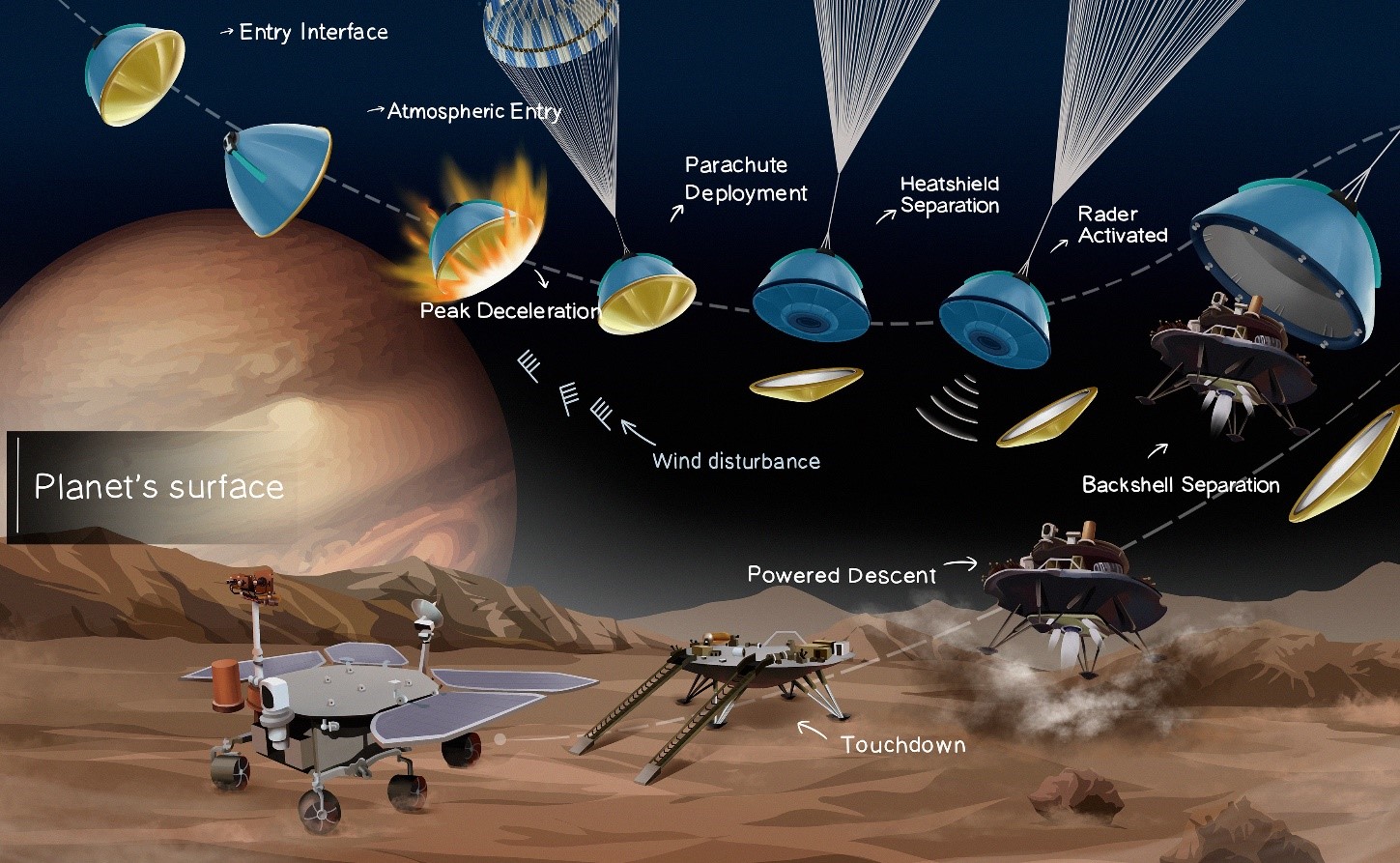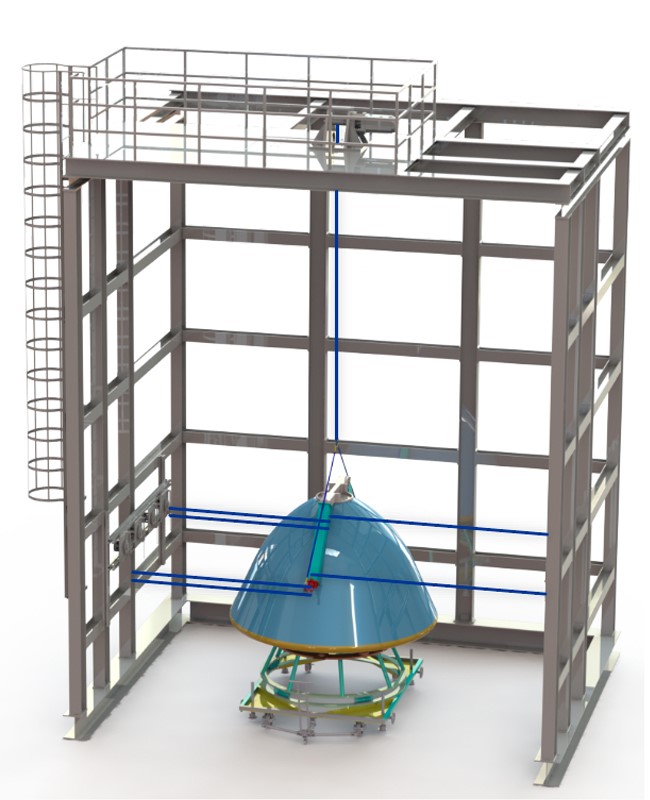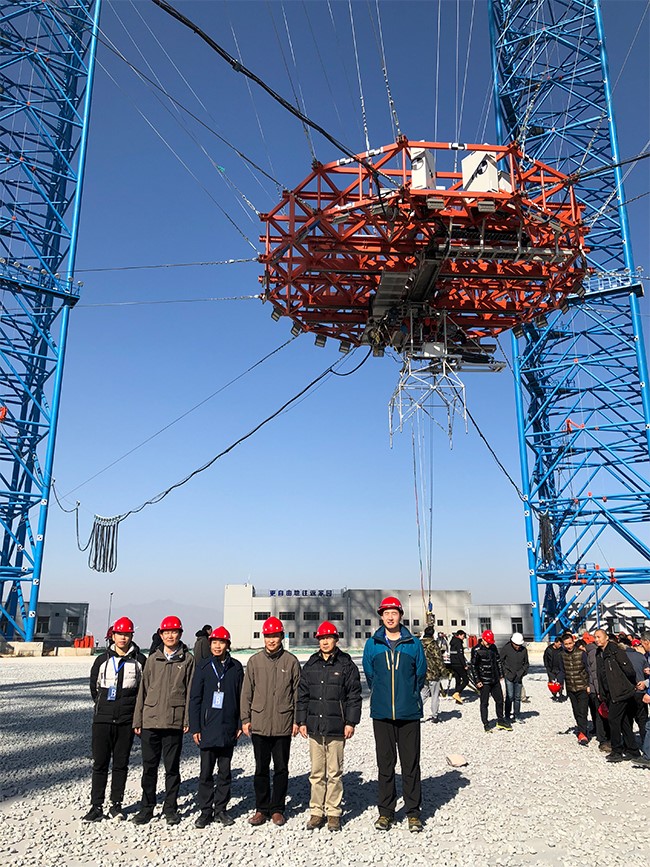A cable system replicating the rough descent through another plant’s atmosphere helped the Tianwen-1 lander become the first non-American lander to set down safely on Mars.
In May this year, when China's Tianwen-1 deployed a working lander on Mars, President Xi Jinping was lavish with praise for the mission's team. “You have brought our country to the global forefront of interplanetary exploration,” he said.
Such are the challenges of the Martian atmosphere that China was only the second country, after the United States, to have landed a working lander Mars’ surface. As NASA’s former chief historian Roger Launius put it; “This is a really big deal.”
A team led by Tsinghua’s Xiaoqiang Tang was instrumental to this milestone. The researchers had developed systems for simulating the Martian environment to test the trickiest and most essential components, the landing equipment. So when Tianwen-1 took off in July 2020, its atmospheric deceleration system had been thoroughly vetted by Tang’s team.
Landing logistics
The Tianwen lander had to follow the same sequence as most space missions landing on other planets (or back on Earth), a process known as Entry, Descent and Landing (EDL).
Initially, China’s lander was allowed to fall freely into Mars's atmosphere at 4.8 km/s. The protective capsule preventing the lander from burning up due to atmospheric friction was blown off with explosive bolts. After the atmosphere became sufficiently dense, parachutes were deployed to slow the lander to subsonic speed. These were jettisoned. Thrusters provided upward force for a gentle touchdown for the last meters of the lander's journey.
NASA engineers have described the descent phase of Mars landing missions as ‘seven minutes of terror’ as it’s the most unpredictable. About 20 attempts to land on Mars have been made by different countries so far. For most, the harrowing interval has been followed only by silence. Among six Russian efforts, for example, the best result was a 1973 landing, with which all contact was lost 130 seconds after touchdown.

In May 2021, China's Tianwen-1 lander completed the process of atmospheric entry, descent and landing on Mars, a feat only ever successfully achieved by NASA previously. It's a famously perilous part of the mission that Tsinghua's Xiaoqiang Tang, Senhao Hou, Haining Sun and Jinhao Wei had already helped simulate hundreds of times using cable-driven parallel robots.
Tang was researching cable-driven parallel robots (CDPRs) before he became involved in China’s space program. These systems use wires, attached to a tested object at different points, to pull it in different directions, thus simulating the forces that will push it around under real conditions. These would eventually be used to bring China success by simulating a landing on Mars hundreds of times, rather than using far fewer expensive aircraft drop tests.
But adjusting for Mars conditions is difficult, says Tang. The planet's atmosphere is about a hundred times thinner than Earth’s, with about one percent of its density. It therefore provides more than enough friction to unpredictably disintegrate the lander’s heat shield capsule, but does little to slow its speed.
Unpredictability is inherent in the ejection forces during the heatshield separation process. The first, when explosive bolts blow off the front heatshield so that landing struts could pop out together with ground scanning sensors to select a suitable surface spot to land. And the second, when the backshell is separated in parallel almost immediately afterwards, with a peak acceleration of 20 m/s2. The lander could also have been buffeted by winds in the Martian atmosphere, about which little is known. Under an extreme scenario, the front heat shield might have been blown backwards after it was ejected, to smash into the lander’s emerging landing gear and permanently disable it.
Simulation efficiencies
Tang had previously used eight and nine-cable CDPRs to test the landers of China's Chang'e lunar missions. Last year, Chang'e 5 returned samples of lunar rock to earth. However, Mars is a unique challenge. Due to its distance, communication with landers is harder and knowledge of the planet is sparser.
There was never disagreement that a soft landing on Mars would be Tianwen-1's biggest challenge. While the Zhurong rover, carried by the lander, is now traversing the red planet's surface with six scientific payloads, its engineering never received the same level of attention.
In the 1970s, Americans tested their two successful 1976 Viking lander missions to Mars in nine separate aircraft drops in the Earth's atmosphere.
China's space agency, the China Aerospace Science and Technology Corporation (CASC), decided against this approach for several reasons. In addition to its high cost, the individual atmospheric conditions surrounding each test could not be controlled, and would take a long time. If they missed the most favorable time window for launch, they would have had to wait two years before they could try again. A method that allowed as much testing as necessary, within a given time, was therefore desirable.
CDPRs have the advantage of being low cost, with short experiment cycles. They can be assembled indoors to test large objects like Tianwen-1's 720 kg lander. If they are adequately engineered, they can accurately deliver a preprogrammed sequence of yanks and shocks, for exhaustive testing within conceivable parameters.

Cable-driven parallel robots (pictured), developed by Xiaoqiang Tang, Senhao Hou, Haining Sun and Jinhao Wei, helped simulate the atmospheric entry, descent and landing conditions on Mars to test China's Tianwen-1 lander (pictured).
Before testing for the Moon missions, Tang developed a six-cable CDPR to test a scale model of China’s giant Five-hundred-meter Aperture Spherical Radio Telescope, before it was rigged up in a Guizhou karst depression in 2016. The size of 30 soccer pitches, it's the world's largest single-dish radio telescope, and it needed to be tested for use during buffeting winds. The telescope became fully operational in 2020.
Red planet replica
Unlike the Moon, Mars has no atmosphere to simulate. When Tianwen's heatshield exploded off with an acceleration of 17 units of g-force, the cable delivering force to it had to keep up without going slack. Tang's machine is a special CDPR, which can simulate axial separation and wind disturbance.
The moon landing was tested by CDPR powered by motors, and while the Mars lander was tested powered by gas springs, which are simpler and more reliable. Researcher, Senhao Hou, worked with Tang to test the Tianwen lander.
In addition to having a much thinner atmosphere, Mars's gravitational field is weaker than Earth's. On average it delivers 38% as much downward acceleration. Researchers, Haining Sun and Jinhao Wei therefore built a second machine for simulating the lander's last, powered descent phase.
Their large-scale gravity compensation system used a vertical cable, attached to the top of the lander, to deliver precisely the amount of upward force needed to reduce the Earth's downward pull to that of Mars.
To achieve this, it relied on three force-delivering mechanisms. A‘big drive system’ (BDS) did the job when the falling lander was between 70 m and 0.8 m from the ground. Below this range, upward force delivered by the lander’s collision with the ground would act against the pull of gravity, so a different, constant force mechanism (CFM) was brought into play. To allow a smooth handover between the two mechanisms, a third' small drive system' (SDS) was used.

Xiaoqiang Tang's team in front of the scaffolding that helped frame their cable-driven Mars simulator.
More Martian missions
Tianwen-1 orbited Mars for nearly three months before releasing its lander. The descent lasted about nine minutes rather than seven, because it went in at a shallower angle than NASA's landers. “Although I was nervous, I was also confident because we had done so many experiments and tests to verify our system,” says Tang, who was monitoring the process with his teammates.
On top of this stunning success, Tang wants to further refine his CDPRs to deliver forces even more precisely and flexibly, across a wider range of parameters. “Different landers are being designed for different planetary environments with more diverse landforms,” he says. “There is an urgent need for a simulation system with more comprehensive functionality, that can be quickly adjusted to suit a target planet.”
China is planning more Mars missions, including one that will return samples to Earth. Doing so will require a much bigger lander, able to achieve lift off from Mars and survive second EDL to get back to Earth. Given that this is far ahead of anything the United States has yet achieved, a race could soon be on to do it first.

